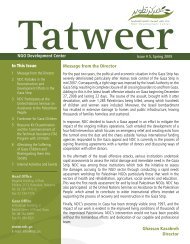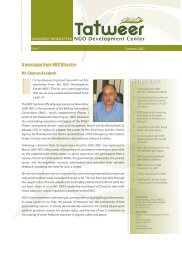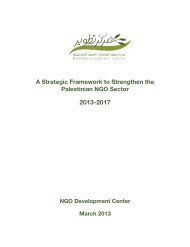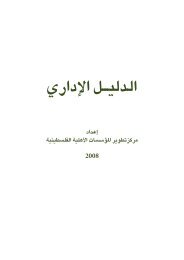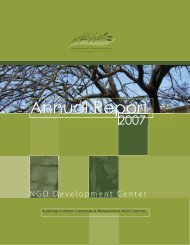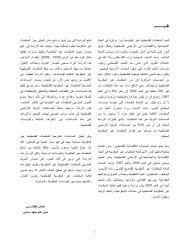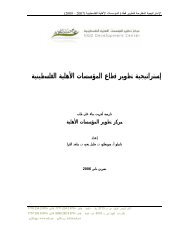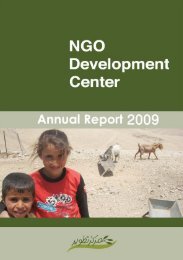Tracking External Donor Funding.pdf - NDC
Tracking External Donor Funding.pdf - NDC
Tracking External Donor Funding.pdf - NDC
Create successful ePaper yourself
Turn your PDF publications into a flip-book with our unique Google optimized e-Paper software.
While the Figure 35 shows a relative stability in the<br />
location of donor HQs in the Central West Bank,<br />
between 2006 and 2008, the number of international<br />
agencies with HQs in Ramallah increases by nearly<br />
10%, mirrored by a near 10% decrease in Jerusalem over<br />
the same period. This trend towards Ramallah from<br />
Jerusalem, in terms of the location of <strong>Donor</strong> Agencies’<br />
HQs, seems to have been mirrored by the percentage of<br />
international aid received by PNGOs in the area. In<br />
1999, 49% of PNGO budgets came from abroad, after<br />
which it had dropped to only 21.4% in 2006. PNGOs<br />
working in Ramallah on the other hand received 37%<br />
and 71.4% of their funding from abroad in 1999 and<br />
2006 respectively (MAS, 2007:76-77).<br />
The Gaza Strip<br />
Our team also looked into the trends of international aid<br />
agencies HQs with respect to the Gaza Strip. As Figure<br />
36 below shows, the number of international aid<br />
agencies with HQs in the Gaza Strip peaked in 2001 at<br />
nearly 12%, before declining to the present level under<br />
5%. The gradual decline between 2001 and 2003<br />
steepens between 2004 and 2005. Between 2005 and<br />
2006, the year of the Israeli ‘Disengagement’ Gaza,<br />
there is a slight rise in international presence, perhaps in<br />
preparation for the coming elections. The following year<br />
though there is another decline into 2007; and since then,<br />
the number of international agencies with HQs in Gaza<br />
has remained just under 5% 45 . It must be noted that over<br />
the two last years of the survey Gaza remained under a<br />
siege, which brought in a number of new international<br />
agencies, such as those from Qatar, and forced out a<br />
number of others who were unable to guarantee access to<br />
their staff or work with the de-facto Hamas<br />
Administration 46 .<br />
The Figure below also details the number of international<br />
agencies with field offices in the Gaza Strip. While the<br />
number of HQs begins to decrease in 2001, the number<br />
of Field Offices begins to increase. However, in 2004,<br />
both the number of HQs and Field Offices begins to<br />
decrease. Between 2007 and 2008, the number of<br />
agencies with Field Offices in the Gaza Strip rises by<br />
more than 5%, perhaps due to the siege requiring<br />
agencies to maintain a permanent staff in the area to<br />
oversee ongoing projects. In 2008 there were only two<br />
international governmental agencies listed as being<br />
headquartered in Gaza, compared to four INGOs.<br />
Largely the same is true of Field Offices as well, where<br />
26 are maintained by INGOs in comparison to 14 by<br />
IGOs or governmental agencies.<br />
Figure 36: International <strong>Donor</strong>s and Agency with HQs in the<br />
Gaza Strip Compared to the Number of International <strong>Donor</strong>s<br />
and Agencies with Field Offices in the Gaza Strip (1999 – 2008)<br />
35%<br />
30%<br />
25%<br />
20%<br />
15%<br />
10%<br />
5%<br />
0%<br />
1999 2000 2001 2002 2003 2004 2005 2006 2007 2008<br />
Head Quarters<br />
Field Offices<br />
Source: PASSIA Directory, 2000 – 2009<br />
45<br />
46<br />
While the number of international agency HQs in Gaza may be low, the amount of dependency on international aid amongst Palestinian NGOs<br />
is quite high. In 2006, with the exception of North Gaza, the remaining four districts’ PNGOs receive the highest percentage of budget from<br />
abroad. In Rafah and Khan Younis it is over 80% (MAS, 2007:76). This dependency on international aid amongst Gazan PNGOs is mirrored by<br />
the Gaza Strip as a whole, where 86% of the population is ‘heavily dependent’ upon international aid (MAS, Economic and Social Monitor 13).<br />
Those agencies receiving USAID funding, for example, are not permitted to communicate or cooperate with individuals or organizations<br />
affiliated to the Hamas party. Since the June 2007 skirmishes resulted in the takeover of the Gaza Strip by Hamas, the line between ‘affiliated’<br />
and ‘unaffiliated’ to Hamas has blurred significantly. Despite this, a number of agencies, even those receiving USAID funds, have continued<br />
working in the Strip and many are planning to increase their activities in the wake of the war on Gaza that began in the closing days of the<br />
period studied.<br />
51


